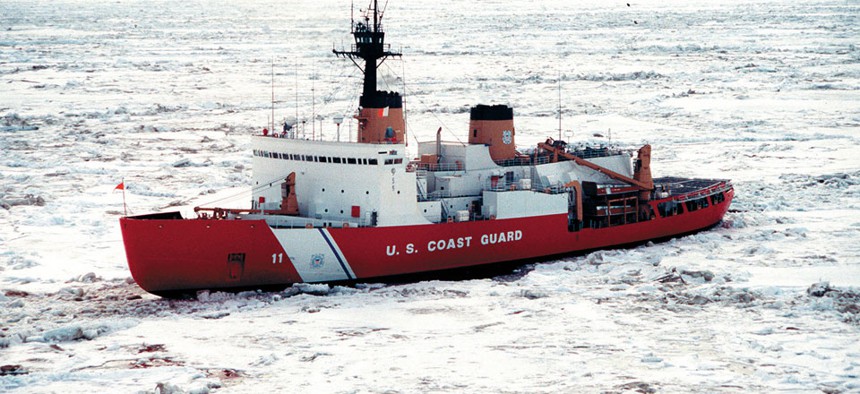What Happened to America's Most Important Arctic Ships?

A U.S. Coast Guard Ice Cutter, Polar Star. U.S. Coast Guard
The nation’s fleet of ice-cutting ships is getting older, and congressional action to modernize it isn’t moving at breakneck speed.
The U.S. Coast Guard is facing a dilemma at the North Pole.
The service's fleet of icebreakers, ships designed to navigate and cut through ice-covered waters in the Arctic and Antarctic regions, is getting older. The vessels themselves are slowly deteriorating, and by 2020, naval experts say the country's icebreaking capabilities will run out.
The powerful ships, which can break through ice up to 6 feet thick, monitor sea traffic, conduct scientific research, and carry out search-and-rescue missions for other nation's ships at both ends of the world. Their presence alone allows the U.S. defend its national security, economic, and environmental interests in the Arctic region, whose vast natural resources have several countries vying for more control.
The Coast Guard currently has four polar icebreakers. The Polar Star, commissioned in 1976, was reactivated in late 2012, after spending eight years getting repairs for worn-out motors. The Polar Sea, commissioned in 1977, has been docked in Seattle since 2011, inoperative because of engine problems.
A third icebreaker, the 14-year-old Healy, has less ice-cutting capability; it mostly supports research. The nation's fourth and final icebreaker is the Nathaniel B. Palmer, a small research vessel built for the National Science Foundation in 1992.
Because of their speed and strength, the polars Star and Sea are the most crucial vessels of the U.S. presence in the polar regions. But both are several years beyond their intended life service of 30 years, and Coast Guard officials are unsure how much life the Polar Star has left. A Coast Guard study in 2011 found that the military service needs at least three active, heavy-duty icebreakers to properly carry out its North Pole duties. For the next few years, if nothing changes, it will have only one.
The timeline for getting a brand new icebreaker appears to be less certain than ever. In its budget submission for fiscal 2013, the Homeland Security Department said it planned to award a construction contract for the ship within the next five years. In its submission for fiscal 2015, there's no mention of a construction contract at all.
A January 2011 report from the DHS inspector general found that the Coast Guard "does not have the necessary budgetary control" over its polar icebreakers, "nor does it have a sufficient number of icebreakers to accomplish its missions in the polar regions."
The budgetary control lies with Congress, which must determine how to modernize the Coast Guard's icebreaker fleet: repair the ships, or build new ones? But the push to address the aging fleet isn't exactly moving at breakneck speed. A House reauthorization bill for Coast Guard spending for the next two yearspassed in April. A Senate version, which includes funding for reactivating the Polar Sea, remains in committee. Late last month, Reps. Rick Larsen, D-Wash., and John Garamendi, D-Calif., wrote a letter to the Coast Guard, asking the service to reactivate the Polar Sea so the U.S. doesn't fall behind in the Arctic.
Repairing and reactivating the Polar Sea for another seven to 10 years of service would take three years and cost about $100 million. A new icebreaker designed to last 30 years would cost $852 million. In its latest budget proposal, the Coast Guard requested $6 million for a preliminary plan to acquire a new icebreaker. Last year, it was granted just $2 million for the project.
In March, Adm. Robert Papp, then the commandant of the Coast Guard, told Congress, "It's going to be tough to fit a billion-dollar icebreaker in our five-year plan without displacing other things."
No country has yet laid full claim to the Arctic region, which is home to 15 percent of the world's oil and a third of its undiscovered natural gas. But the U.S. is about to gain a lot more responsibility there, thanks to its turn as the chair of the Arctic Council, a forum of polar nations, next year. A young and capable fleet of icebreakers would certainly come in handy then.



